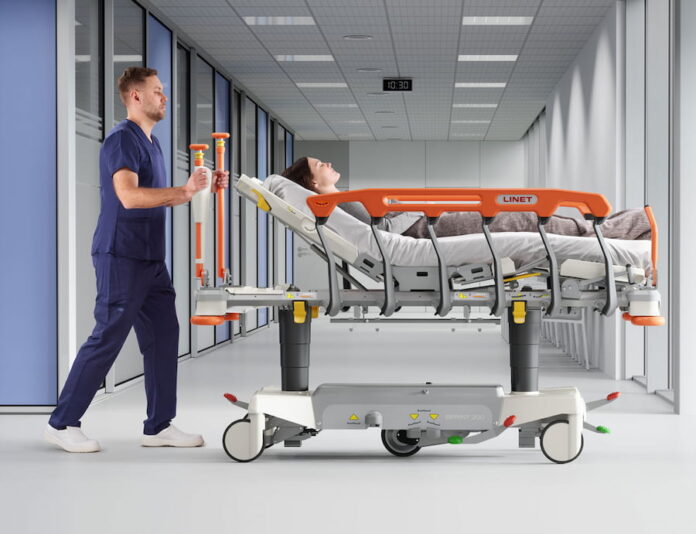In the fast-paced world of healthcare, the seamless transfer of patients between facilities ensures the best medical outcomes. However, there is far more to patient transfers than simply wheeling them into an ambulance and dropping them off at a different medical facility.
Transfers typically involve several entities other than the patient and, as a result, they can be surprisingly complex. Things can become even more complicated if the patient has special needs that have to be considered during and immediately after the transport process. Additionally, a lot of paperwork needs to be filled out to ensure payment and to make sure that each patient gets the care they need.
Patient transfer request workflows can vary significantly between facilities and are occasionally done in an ad hoc manner. With so many potential complications, transfers could often be slow and tedious, particularly when facilitated by inexperienced teams or ones that are not specifically trained in process optimization.
Partnering with a professional transport provider offers healthcare facilities and patients well-defined and efficient transfer request workflows. In this short guide, we’ll outline the basic steps of an ideal patient transfer request workflow, highlighting how it facilitates seamless patient transfers and improves the quality of care.
1) Staff Requests Transport
Rather than paper forms, professional transportation services will usually have some type of software or a patient transfer solution in place to track and request transports. If the facility has a patient transfer solution, the staff can login to the provider’s online portal to fill out a short questionnaire to inform the transport provider about the patient and their special transport requirements. Once the questionnaire is filled out and confirmed, the next step of the process may begin automatically.
Without the patient transfer solution, the staff will need to get in touch with their in-house ambulance team or with other service providers by phone. If the in-house team or the provider they call does not have suitable transport available, the staff will need to either wait for a vehicle, make compromises on the transport option, or call another provider. In all cases, delays can occur that result in a potential risk to the patient and further inconvenience down the line.
2) Transport Service Accepts Request
Once the questionnaire is complete, the patient transfer solution will typically send out notifications to transport providers through text and email. If a transport provider accepts the request, the staff will be immediately notified. If there are no vehicles available, the ride will be automatically queued to receive the next available transport, minimizing the need for phone calls to explain the situation.
In traditional patient transport workflows, all these processes will be handled manually, if at all. Because providers may have to handle multiple requests at a time, some patients may not get the priority that they need.
3) Paperwork Is Completed Automatically
Transportation service providers will use the information on submitted questionnaires to automatically fill out all the needed electronic forms, including Medical Necessity or Physician Certification forms. This minimizes clerical errors as well as the need for transport stakeholders to rewrite or retype the same information. This results in much better data accuracy and prevents payment from delay.
In typical workflows, everyone involved in the transfer may have to fill out various forms, which often times gets neglected. This uses up precious minutes that should, instead, be used for patient care and transportation. Additionally, this process is error-prone and occasionally disregarded, leaving the patient at risk from medical care errors.
4) Real-Time Updates Are Given to All Parties
The best medical transportation solution typically has systems that send real-time status updates to everyone involved in a patient’s transport. Updates can be sent not only to the drivers and crew directly involved in the patient’s care, but also to the staff at receiving facilities, the patient’s family members, and the patient themselves. This makes the entire process completely transparent and reduces the delays that would have otherwise been created by different stakeholders having to contact each other.
In contrast, sending out updates following the traditional workflow is much slower, requiring different parties to constantly interface with each other. As a result, updates are often inaccurate or non-existent, with no single person fully understanding all of the specifics of a patient’s case. This lack of transparency can cause delays and errors that may put the patient at serious risk.
While there may be some slight differences, the best transport providers generally follow the steps above, as this automated workflow can shave off minutes, if not hours, of waiting time. Taking a wider view, these workflows benefit everyone who needs medical transport within the service area. Ultimately, following a workflow similar to what’s described allows crews to spend more time transporting patients and less time getting bogged down in paperwork.
Most importantly, these systems also lead to better patient outcomes. With less time spent waiting for transport, patients with critical or delicate conditions have a better chance of receiving critical care on time. By partnering with a professional transport provider that understands workflow management, healthcare facilities can confidently elevate the standard of care that their patients receive.
Read Also
- How to Drive Growth Through Customer Centricity in HealthcareThe world of healthcare is changing in big ways. Consumers are now stepping up and taking charge of their health journeys. This change is happening now for important reasons. The U.S. health and wellness market is huge, projected to be over $6 trillion in 2025. This growth is fueled by rising out-of-pocket costs and more… Read more: How to Drive Growth Through Customer Centricity in Healthcare
- Maximizing Digital Reach for Podiatry Clinics in Local HealthcareMaximizing Digital Reach for Podiatry Clinics in Local Healthcare As the healthcare industry evolves, mobile marketing becomes indispensable for practitioners. Podiatry clinics, focusing on foot and ankle care, must adapt to digital strategies to engage patients effectively. Implementing tailored SEO practices is crucial for these clinics to thrive in an increasingly competitive market. Digital marketing… Read more: Maximizing Digital Reach for Podiatry Clinics in Local Healthcare
- Leveraging Virtual Medical Assistants to Maximize Operational Efficiency in HealthcareIn the increasingly complex and fast-paced world of healthcare, operational efficiency is critical. Doctors and healthcare administrators are faced with numerous challenges, from managing patient scheduling and medical billing to adhering to stringent regulatory compliance and insurance claims processing. These tasks, while essential, often divert time and resources away from the core mission of providing… Read more: Leveraging Virtual Medical Assistants to Maximize Operational Efficiency in Healthcare
- Optimizing CT Protocols: The Hidden Key to Efficiency and Cost Savings in RadiologyIntroduction: Why CT Protocol Optimization Matters Computed Tomography (CT) is a cornerstone of modern diagnostic imaging, providing critical information across nearly every medical specialty. However, maximizing the value of CT — both clinically and financially — requires more than just advanced hardware. The real secret lies in the optimization of CT protocols. When CT protocols… Read more: Optimizing CT Protocols: The Hidden Key to Efficiency and Cost Savings in Radiology
- Hospital Discharge Accuracy Improves With Daily Advisor InvolvementThe hospital discharge process has a big effect on patient recovery, hospital efficiency, and finances. It requires careful planning and clear communication between team members to make sure patients get the right care when they leave the hospital. Having physician advisors involved at this stage can improve the discharge process by spotting problems that need… Read more: Hospital Discharge Accuracy Improves With Daily Advisor Involvement
- Understanding Clinical Trials: What to Learn and the RoadblocksClinical trials are research studies conducted to determine the efficacy of medical, surgical or behavioral interventions. They are the most commonly used way that researchers assess whether new treatments, drugs or medical devices are safe and effective for use in humans. There are strict protocols governing these studies, and all of this is done in such a… Read more: Understanding Clinical Trials: What to Learn and the Roadblocks
- The Patient’s Voice: 7 Ways to Improve TelehealthTelehealth has transformed how we access healthcare, making it more convenient and accessible than ever before. However, as this technology evolves, so does the need for improvement. Patient feedback is essential in shaping these telehealth experiences. It offers valuable insights into what works, what doesn’t, and how we can make virtual care even better. Currently,… Read more: The Patient’s Voice: 7 Ways to Improve Telehealth








